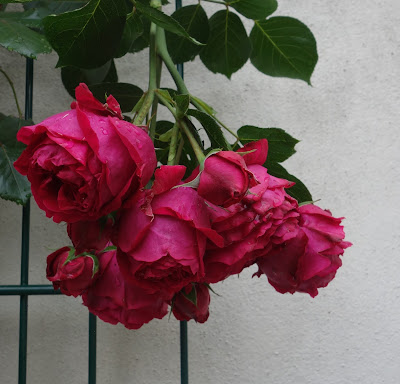Not being French myself, you may scoff at my taking liberties
with one of the Frenchy-est of dishes. I
assure you, I mean no disrespect, especially when cooking with good French
wine. My recipe calls for a whole bottle!
And truly, as in so many French wonders of la cuisine, I feel certain that every French chef, from amateur to mother-teur
to master-teur painted their own shades of culinary color on Burgy-Beef. Vive la
difference!
To be brief, Beef Bourguignon is really beef stew, but cooked
with wine, herbs, and vegetables, over time, the flavors of this stew become
magically and delightfully complex.
The one thing to remember about Beef Bourguignon is IT TAKES
TIME. Try to do this recipe in an hour
and your guests will stomp out in disgust, leaving your reputation in tatters,
your spouse sobbing, and your children fighting over the peanut butter.
The good news is, you can make this dish a day or two before,
and the flavor becomes even better.
I know you would feel slighted if I let l’histoire, the story of Burgy-Beef, end after that breezy intro. Your well-traveled imagination needs to savor
a bit of history and intrigue. I strive
to allay your fears and feed your lust for knowledge. I see you’re quivering in anticipation. You
YEARN to know who started this delicious beef stew and so forth. Quiver no
more.
It began with cattle, as you might guess from the name, which
is not Caterpillar or Muskrat or Hind-end-of-Donkey Bourguinon. In a short phrase, it began with Charolais
cattle, known for their tender, lean meat.
These hoofed wonders come from the Charolles region of southern
Burgundy. I confess I do not know who
started this marvel of the French kitchen, but I feel safe in saying it was not
a highly paid chef in a restaurant with more stars than the five Chiefs of
Staff. I do know it who made it famous. Chef Auguste Escoffier with his 1903 cookbook,
Le Guide Culinaire. Now, here’s the intrigue. Escoffier was later fired from London’s Savoy
Hotel for cooking the books. That really stirred things up.
Julia Child made some changes to Escoffier’s original recipe,
the main one being that she chose to cut the beef into cubes rather than
cooking it whole. As for your chef de jour, I follow Julia.
Rather than continuing with things you will not even remember
between text messages, here’s the recipe:
Beef Bourguignon Chez Stroud
3 ½ pounds (approx. 1.6 kilos) chuck roast, cut into 2 inch
cubes. Don’t remove too much fat, but do
remove any tough connecting tissue
750 ml Burgundy wine, or another heavy red wine
1 large onion, diced
2 stalks of celery, thin sliced
2 medium sized tomatoes, seeds removed, blended into a purée
20 medium sized mushrooms, trimmed, washed, and quartered
4 large carrots, peeled and cut into thick chunks
2 cloves garlic, diced
4 slices streaky bacon, roughly chopped
2 heaping tablespoons of Bovril or another beef concentrate
1 heaping tablespoon herbs de Province (No H de P? Use thyme,
parsley, bay leaves or just use your imagination…Hey! You’re the Chef!)
olive oil, salt, pepper
1 cup water
Roux: make a paste of
two tablespoons of butter mashed into two tablespoons of flour. This will be used to thicken the stew after
it comes out of the oven.
You’ll also need: a
large heavy bottomed pot with a lid (Dutch oven).
Put the cubes of beef in a large bowl and pour in the entire
bottle of wine. Cover and let the beef
marinate for a couple of hours.
Why? Wine tenderizes.
Heat the oven to 250ºF
(130ºC)
Remove the beef from the bowl, but save the marinade. Splash some olive oil in your large pot and
brown the beef in batches. I did it with
three batches. When the beef is browned,
place it in a colander over a bowl (to catch the juices).
When all the meat is browned and removed, splash some more
oil in the pot, then toss in the onions, garlic, celery, and bacon. Cook at medium heat until the onions are
wilted and beginning to turn amber. Mix
in the tomato purée, stir and cook only a few moments.
Return the beef to the pot and pour in the wine marinade and
the dripping from the beef. Bring to a
boil and stir in the Bovril. Add the cup
of water. Add salt and pepper to taste.
Put the top on the pot, slide it in the pre-heated oven and
cook for about four hours.
At the three hour point, add the carrots and mushrooms.
I like my Burgy-Beef rich and thick, so after removing the
stew from the oven, I put it back on the stovetop at low heat. As it bubbles, I stir in the roux (paste) and
cook the stew for a few minutes more, until thickened.
I like to serve this with plain mashed potatoes and as much
wine as I can drink. The French would
also accompany the meal with slices of crusty baguette. The French don’t even
brush their teeth without a baguette close by.
But wait….there’s just a bit more. What does Bourgignon mean? Well in English, we say Burgundy, but in
French it ‘s Bourgogne. And the French word Bourgignon (Boor-gig-yawn) comes out Burgundian in English. Beef Burgundy style! Voilá!
A votre santé!
 |
| browning the beef |
 |
| sliced onions, celery, and finely diced garlic |
 |
| tomato purée |
 |
| draining the beef, but catching the juices in a bowl below the colander |
 |
| I never make a beef stew or soup without the magic of Bovril |





















































